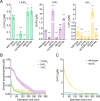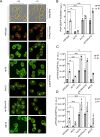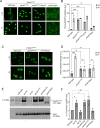Inositol pyrophosphate dynamics reveals control of the yeast phosphate starvation program through 1,5-IP8 and the SPX domain of Pho81
- PMID: 37728314
- PMCID: PMC10511240
- DOI: 10.7554/eLife.87956
Inositol pyrophosphate dynamics reveals control of the yeast phosphate starvation program through 1,5-IP8 and the SPX domain of Pho81
Abstract
Eukaryotic cells control inorganic phosphate to balance its role as essential macronutrient with its negative bioenergetic impact on reactions liberating phosphate. Phosphate homeostasis depends on the conserved INPHORS signaling pathway that utilizes inositol pyrophosphates and SPX receptor domains. Since cells synthesize various inositol pyrophosphates and SPX domains bind them promiscuously, it is unclear whether a specific inositol pyrophosphate regulates SPX domains in vivo, or whether multiple inositol pyrophosphates act as a pool. In contrast to previous models, which postulated that phosphate starvation is signaled by increased production of the inositol pyrophosphate 1-IP7, we now show that the levels of all detectable inositol pyrophosphates of yeast, 1-IP7, 5-IP7, and 1,5-IP8, strongly decline upon phosphate starvation. Among these, specifically the decline of 1,5-IP8 triggers the transcriptional phosphate starvation response, the PHO pathway. 1,5-IP8 inactivates the cyclin-dependent kinase inhibitor Pho81 through its SPX domain. This stimulates the cyclin-dependent kinase Pho85-Pho80 to phosphorylate the transcription factor Pho4 and repress the PHO pathway. Combining our results with observations from other systems, we propose a unified model where 1,5-IP8 signals cytosolic phosphate abundance to SPX proteins in fungi, plants, and mammals. Its absence triggers starvation responses.
Keywords: C. neoformans; Cryptococcus neoformans; PHO pathway; SPX domain; biochemistry; cell biology; chemical biology; fungal pathogens; inositol pyrophosphate; nutrient signaling; phosphate homeostasis; saccharomyces cerevisiae; schizosaccharomyces pombe.
© 2023, Chabert, Kim et al.
Conflict of interest statement
VC, GK, DQ, GL, LM, MJ, HJ, AM No competing interests declared
Figures
















Update of
- doi: 10.1101/2023.02.14.528555
- doi: 10.7554/eLife.87956.1
- doi: 10.7554/eLife.87956.2
Similar articles
-
IP7-SPX Domain Interaction Controls Fungal Virulence by Stabilizing Phosphate Signaling Machinery.mBio. 2020 Oct 20;11(5):e01920-20. doi: 10.1128/mBio.01920-20. mBio. 2020. PMID: 33082258 Free PMC article.
-
Tandem inactivation of inositol pyrophosphatases Asp1, Siw14, and Aps1 illuminates functional redundancies in inositol pyrophosphate catabolism in fission yeast.mBio. 2025 May 14;16(5):e0038925. doi: 10.1128/mbio.00389-25. Epub 2025 Apr 16. mBio. 2025. PMID: 40237466 Free PMC article.
-
Activities and Structure-Function Analysis of Fission Yeast Inositol Pyrophosphate (IPP) Kinase-Pyrophosphatase Asp1 and Its Impact on Regulation of pho1 Gene Expression.mBio. 2022 Jun 28;13(3):e0103422. doi: 10.1128/mbio.01034-22. Epub 2022 May 10. mBio. 2022. PMID: 35536002 Free PMC article.
-
IP8: A quantitatively minor inositol pyrophosphate signaling molecule that punches above its weight.Adv Biol Regul. 2024 Jan;91:101002. doi: 10.1016/j.jbior.2023.101002. Epub 2023 Dec 1. Adv Biol Regul. 2024. PMID: 38064879 Review.
-
Phosphate Acquisition and Virulence in Human Fungal Pathogens.Microorganisms. 2017 Aug 22;5(3):48. doi: 10.3390/microorganisms5030048. Microorganisms. 2017. PMID: 28829379 Free PMC article. Review.
Cited by
-
A metabolite sensor subunit of the Atg1/ULK complex regulates selective autophagy.Nat Cell Biol. 2024 Mar;26(3):366-377. doi: 10.1038/s41556-024-01348-4. Epub 2024 Feb 5. Nat Cell Biol. 2024. PMID: 38316984 Free PMC article.
-
Arg1 from Cryptococcus neoformans lacks PI3 kinase activity and conveys virulence roles via its IP3-4 kinase activity.mBio. 2024 Jun 12;15(6):e0060824. doi: 10.1128/mbio.00608-24. Epub 2024 May 14. mBio. 2024. PMID: 38742909 Free PMC article.
-
Inositol pyrophosphates activate the vacuolar transport chaperone complex in yeast by disrupting a homotypic SPX domain interaction.Nat Commun. 2023 May 8;14(1):2645. doi: 10.1038/s41467-023-38315-w. Nat Commun. 2023. PMID: 37156835 Free PMC article.
-
Synthesis of a New Purine Analogue Class with Antifungal Activity and Improved Potency against Fungal IP3-4K.ACS Infect Dis. 2025 Apr 11;11(4):940-953. doi: 10.1021/acsinfecdis.4c00975. Epub 2025 Mar 31. ACS Infect Dis. 2025. PMID: 40164150 Free PMC article.
-
A systematic study of regulating inorganic polyphosphates production in Saccharomyces cerevisiae.Synth Syst Biotechnol. 2025 Apr 10;10(3):816-826. doi: 10.1016/j.synbio.2025.04.004. eCollection 2025 Sep. Synth Syst Biotechnol. 2025. PMID: 40291979 Free PMC article.
References
-
- Adepoju O, Williams SP, Craige B, Cridland CA, Sharpe AK, Brown AM, Land E, Perera IY, Mena D, Sobrado P, Gillaspy GE. Inositol Trisphosphate Kinase and Diphosphoinositol Pentakisphosphate Kinase Enzymes Constitute the Inositol Pyrophosphate Synthesis Pathway in Plants. bioRxiv. 2019 doi: 10.1101/724914. - DOI
-
- Auesukaree C, Tochio H, Shirakawa M, Kaneko Y, Harashima S. Plc1p, Arg82p, and Kcs1p, Enzymes involved in inositol Pyrophosphate synthesis, are essential for Phosphate regulation and Polyphosphate accumulation in Saccharomyces cerevisiae. Journal of Biological Chemistry. 2005;280:25127–25133. doi: 10.1074/jbc.M414579200. - DOI - PubMed
Publication types
MeSH terms
Substances
LinkOut - more resources
Full Text Sources

